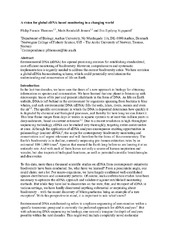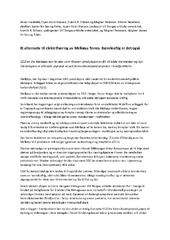Norges fiskerihøgskole: Recent submissions
Now showing items 41-60 of 1758
-
A vision for global eDNA-based monitoring in a changing world
(Journal article; Tidsskriftartikkel; Peer reviewed, 2024-05-15)Environmental DNA (eDNA) has opened promising avenues for establishing standardized, cost-efficient monitoring of biodiversity. However, comprehensive and systematic implementation is urgently needed to address the current biodiversity crisis. Here, we envision a global eDNA biomonitoring scheme, which could potentially revolutionize the understanding and conservation of life on Earth. -
Metabolomics-Guided Discovery of Bipolarolides H−O, New Ophiobolin-Type Sesterterpenes with Antibacterial Activity from the Marine-Derived Fungus Uzbekistanica storfjordensis sp. nov.
(Journal article; Tidsskriftartikkel; Peer reviewed, 2025-01-30)A marine-derived Pleosporales fungus, Uzbekistanica storfjordensis, was isolated from driftwood and described as a new species. The fungus was cultivated in liquid media and a molecular networking-driven approach was used to identify potential new secondary metabolites. The targeted compounds were isolated using preparative HPLC-MS, and through extensive spectroscopic analysis, eight new ophiobolin-type ... -
Effect of mesh size in monofilament and multifilament gillnets on catch efficiency in the Black Sea whiting (Merlangius merlangus) fishery
(Journal article; Tidsskriftartikkel; Peer reviewed, 2024-02-26)Gillnets are widely used fishing gear for targeting various fish species. Gillnet fisheries use different gear configurations such as different mesh sizes and number of netting twines (mono- or multifilament) depending on the species targeted. Gillnet fishery targeting whiting (Merlangius merlangus) is one of the economically important year-round fisheries in the Black Sea. However, large bycatch ... -
Use of floated gillnet to reduce flatfish bycatch in a mixed-species gillnet fishery
(Journal article; Tidsskriftartikkel; Peer reviewed, 2024-05-24)Bycatch of threatened flatfish species is a major concern in mixed-species bottom-set gillnet fisheries in the Yellow Sea, China. Therefore, we tested floated gillnets against standard bottom-set gillnets to reduce bycatch by exploiting difference in species-specific fish behavior. Our results demonstrated that the floated gillnet design can greatly improve species and size selectivity. Floated ... -
Semi-pelagic trawling in the U.S. West Coast groundfish bottom trawl fishery: Effects on catch efficiency and seafloor interactions
(Journal article; Tidsskriftartikkel; Peer reviewed, 2024-07-15)Reducing the impacts of bottom trawling on seafloor habitats is a management priority in the U.S. West Coast groundfish bottom trawl fishery as well as other trawl fisheries internationally. Modifications to conventional bottom trawls, such as semi-pelagic trawl technology, are commonly used in demersal fisheries to reduce trawl-seafloor interactions by elevating the doors and portions of the sweeps ... -
Et alternativ til elektrifisering av Melkøya finnes. Bærekraftig er det også
(Chronicle; Kronikk, 2025-01-02)CO2-en fra Melkøya kan brukes som råvare i produksjon av fôr til både mennesker og dyr. Teknologien er allerede utprøvd ut ved ferrosilisiumproduksjonen i Finnfjordbotn. -
Extracellular traps in skin lesions infected with lymphocystis disease virus in black rockfish (Sebastes schlegelii)
(Journal article; Tidsskriftartikkel; Peer reviewed, 2024-05-18)The lymphocystis disease (LCD), caused by Lymphocystis disease virus (LCDV), is a benign and self-limiting disease described in a many freshwater and marine fish species. Hypertrophic fibroblasts and extensive aggregation of inflammatory cells are characteristics of LCD. In the present study, small animal imaging and ultrastructural investigations were carried out on the lymphocystis nodules of black ... -
Effects of prolonged application of peracetic acid-based disinfectant on recirculating aquaculture systems stocked with Atlantic salmon parr
(Journal article; Tidsskriftartikkel; Peer reviewed, 2024-06-07)The use of recirculating aquaculture systems (RAS) for Atlantic salmon (Salmo salar) production has become increasingly common. RAS water disinfection plays a crucial role on its biosecurity. Peracetic acid (PAA) is a promising disinfectant due to its powerful oxidative properties, broad antimicrobial spectrum, and rapid degradation into no harmful compounds. This study focused on assessing the ... -
Ontogeny of myeloperoxidase (MPO) positive cells in flounder (Paralichthys olivaceus)
(Journal article; Tidsskriftartikkel; Peer reviewed, 2024-04-10)Neutrophils represent an important asset of innate immunity. Neutrophils express myeloperoxidase (MPO) which is a heme-containing peroxidase involved in microbial killing. In this study, by using real-time quantitative PCR and Western blot analysis, the flounder MPO (PoMPO) was observed to be highly expressed in the head kidney, followed by spleen, gill, and intestine during ontogeny – during ... -
Satisfying Norwegian appetites: Decoding regional demand for shrimp
(Journal article; Tidsskriftartikkel; Peer reviewed, 2024-07-25)This study investigates the regional demand for shrimp in Norway by employing the linear approximated Almost Ideal Demand System (LA/AIDS) framework. Shrimp consumption has grown significantly globally, with Norway being no exception. The LA/AIDS model allows us to examine the demand of shrimp across different regions in Norway. We utilize comprehensive data on regional shrimp consumption, prices, ... -
Giant viruses inhibit superinfection by downregulating phagocytosis in Acanthamoeba
(Journal article; Tidsskriftartikkel; Peer reviewed, 2024-09-03)In the context of the virosphere, viral particles can compete for host cells. In this scenario, some viruses block the entry of exogenous virions upon infecting a cell, a phenomenon known as superinfection inhibition. The molecular mechanisms associated with superinfection inhibition vary depending on the viral species and the host, but generally, blocking superinfection ensures the genetic supremacy ... -
Adjuvant effects of β-defensin on DNA vaccine OmpC against edwardsiellosis in flounder (Paralichthys olivaceus)
(Journal article; Tidsskriftartikkel; Peer reviewed, 2024-03-11)β-defensin of flounder plays an important role in immunomodulation by recruiting immune cells and has a potential vaccine adjuvant effect in addition to its bactericidal activity. In this study, adjuvant effects of β-defensin on DNA vaccine OmpC against edwardsiellosis in flounder (Paralichthys olivaceus) were investigated. The bicistronic eukaryotic expression plasmid pBudCE4.1 plasmid vector with ... -
Implementing the water-energy-food nexus approach to create synergies and reduce tradeoffs between the Sustainable Development Goals
(Journal article; Tidsskriftartikkel; Peer reviewed, 2024-03-11)The Food-Energy-Water nexus approach to resource governance is a paradigmshifting approach that moves away from “siloed” resource management and pursues integration and holistic planning between food, energy, and water governance. The Food-Energy-Water nexus approach carries the potential to increase synergies and reduce tradeoffs between the Sustainable Development Goals. However, theoretical ... -
Konseptbeskrivelse for bærekrafts-rapportering i FiskInfoPlattformen
(Research report; Forskningsrapport, 2024-12-19)Denne rapporten utreder konseptet FiskInfoPlattformen: en digital plattform for fangst og bærekraftsrapportering basert på operasjonell datafangst under fiske. Arbeidet har tatt utgangspunkt i grunnstammen i veikartet for databaserte fiskeritjenester som ble etablert i FHF prosjekt 901803 og er første steg i å utvide dette med nødvendig dataflyt for å støtte bærekraftsrapportering. FNs bærekraftsmål ... -
Biogenic dietary promoters in aquaculture: nature-based solutions for enhancing growth, health, and sustainability
(Journal article; Tidsskriftartikkel; Peer reviewed, 2024-11-27)Aquaculture, as a rapidly expanding global industry, is increasingly challenged by both infectious and non-infectious diseases, posing significant threats to fish health and production. Traditional interventions, such as antibiotics and vaccines, though effective, raise concerns regarding environmental impact and the potential for resistance development. This review explores the promising role of ... -
Transcriptionally distinct B cell profiles in systemic immune tissues and peritoneal cavity of Atlantic salmon (Salmo salar) infected with salmonid alphavirus subtype 3
(Journal article; Tidsskriftartikkel; Peer reviewed, 2024-12-03)Teleost B cells producing neutralizing antibodies contribute to protection against salmonid alphavirus (SAV) infection, the etiological agent of pancreas disease, thereby reducing mortality and disease severity. Our previous studies show differences in B cell responses between the systemic immune tissues (head kidney (HK) and spleen) and the peritoneal cavity (PerC) after intraperitoneal SAV3 ... -
Promising Probiotic Candidates for Sustainable Aquaculture: An Updated Review
(Journal article; Tidsskriftartikkel; Peer reviewed, 2024-12-17)With the intensification of aquaculture to meet the rising demands of fish and shellfish, disease outbreaks during the larval and adult stages are a major challenge faced by aqua culturists. As the prophylactic use of vaccines and antibiotics has several limitations, research is now focused on sustainable alternatives to vaccines and antibiotics, e.g., medicinal plants, probiotics, postbiotics, ... -
No Sign of Homogenisation in Reef Fish Communities Across an Ecological Transition Zone Exposed to Warming
(Journal article; Tidsskriftartikkel; Peer reviewed, 2024-11-28)Aim: Marine organisms are responding to warming by altering their distribution ranges, causing biogeographic range shifts and in some cases, favouring the community homogenisation. Transition zones can act as natural laboratories to explore the consequences of homogenisation. However, these habitats are relatively poorly studied in coastal areas. In this study, we aimed to investigate biotic ... -
Quality parameters and storage stability of the Norwegian red sea cucumber (Parastichopus tremulus)
(Journal article; Tidsskriftartikkel; Peer reviewed, 2025-01-03)Quality parameters and storage stability were evaluated through biochemical, textural, and microbial analyses of the Norwegian red sea cucumber Parastichopus tremulus at two different storage temperatures (0 °C and 4 °C) over 17 days. During storage, the pH decreased from 7 to 6.3, the texture became softer decreasing from 47.3 to 0.3 N, while K-value increased from 4 to 52 %, microbial counts ... -
Differential regulation of magnesium transporters Slc41, Cnnm and Trpm6-7 in the kidney of salmonids may represent evolutionary adaptations to high salinity environments
(Journal article; Tidsskriftartikkel; Peer reviewed, 2024-11-29)Magnesium is important for enzymatic reactions and physiological functions, and its intracellular concentration is tightly regulated. Atlantic salmon has the ability to handle large changes in environmental Mg<sup>2+</sup> concentration when migrating between freshwater and seawater habitats, making it a relevant model to investigate Mg<sup>2+</sup> homeostasis. Parr-smolt transformation (PST) is ...


 English
English norsk
norsk


















